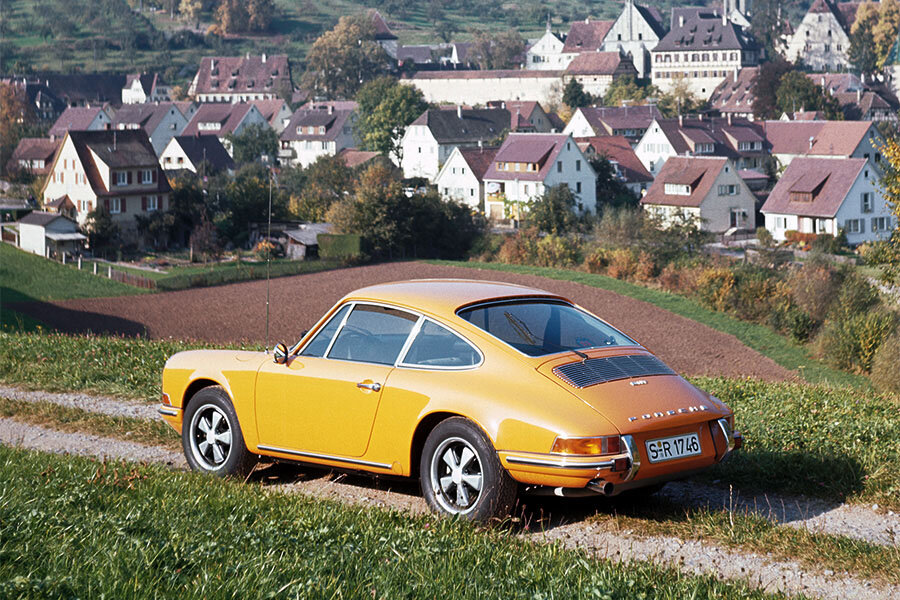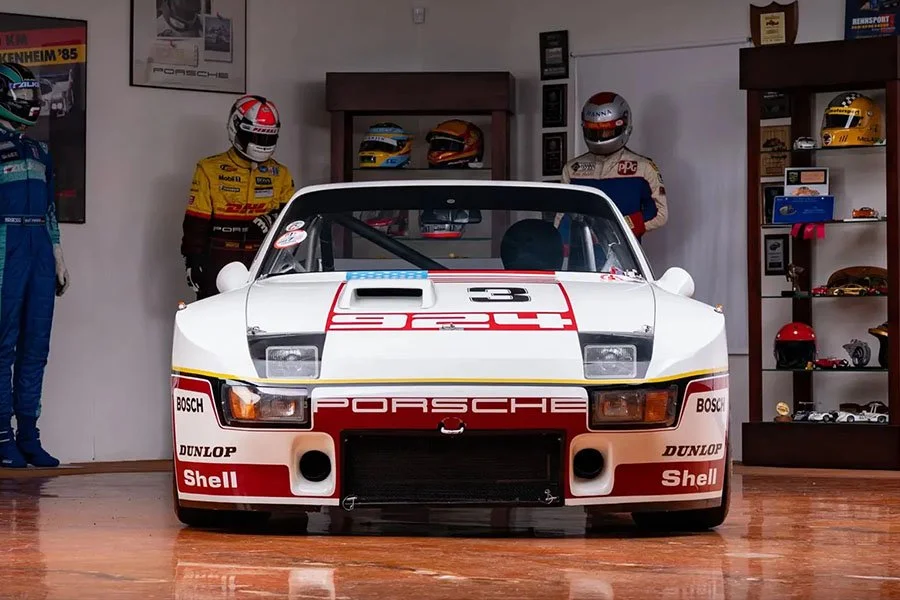Guide: Porsche 911 2.2 C & D-series - a Historical & Technical Appraisal
/BACKGROUND
Porsche’s first 21 years as an auto manufacturer had seen the firm grow at an exponential rate.
From the trickle of hand-built Volkswagen-based 356s that emerged out of a cramped converted sawmill in the backwaters of Austria, the company had returned to Germany where workshop space was leased until there was enough money for a brand new factory.
The expectation had been that maybe a few hundred 356s would satisfy demand. By the time production stopped in 1965, nearly 80,000 had been delivered.
The move further upmarket with the larger six cylinder 911 was a gamble but ultimately paid off; it was not just a critically acclaimed commercial success, but quickly came to be regarded as an icon of 20th century automotive design.
After four years in production, Porsche released a 911 with a larger 2.2-litre engine. The original two-litre unit had served the firm well, but the move to a bigger displacement for the 1970 model year meant more power, improved torque and, most importantly, better performance.
For most of the 1960s, Porsche had the mid-range GT market pretty much sewn up. However, the 911’s enormous commercial success did not go unnoticed over at Ferrari, Lamborghini and Maserati. All three Italian firms had entry level 2+2 models in the pipeline and were determined to attract customers that would otherwise have purchased a 911.
With competition hotting up, the C-series 911 entered production in August 1969.
These 2.2-litre 911s were manufactured for the 1970 and 1971 model years during which time, Porsche joined the big league by taking back-to-back wins at the Le Mans 24 Hours with their Flat 12-engined 917s.
Although it had been Ford that first broke Ferrari’s dominance at Le Mans, sports car racing throughout the 1970s and 1980s would be dominated by Porsche.
This latest 911 was once again available as either a Coupe or Targa and customers could choose from engines in three alternative states of tune: there was the entry level 125bhp 911 T, the more luxurious 155bhp 911 E or the flagship 180bhp 911 S.
ENGINE / TRANSMISSION
The familiar all-alloy air-cooled Flat 6 with its single overhead camshafts and dry-sump lubrication was bored from 80mm to 84mm. Stroke stayed at 66mm for a displacement of 2195cc (a gain of 204cc over the outgoing unit).
Porsche’s engineers fitted bigger valves, new head gaskets and more cooling fins on the cylinder barrels which had modified ends to clear the longer bolts required by stronger con rods.
Engine type numbers were given a 911 instead of 901 prefix and specifications were as follows:
911 T: Type 911/03, 125bhp at 5800rpm / 177lb-ft at 4200rpm, 8.6:1 compression, two Zenith 40 TIN carburettors.
911 E: Type 911/01, 155bhp at 6200rpm / 191lb-ft at 4500rpm, 9.1:1 compression, Bosch mechanical fuel-injection.
911 S: Type 911/02, 180bhp at 6500rpm / 199lb-ft at 5200rpm, 9.8:1 compression, Bosch mechanical fuel-injection.
Cheaper Zenith carburettors replaced the Webers on the new 911 T which also now came with the CD ignition fitted to the rest of the range. Compression was unchanged. Output rose by 15bhp and 21lb-ft at the same engine speeds as before.
The 911 T was the only 2.2-litre derivative that had a specific US-market version as the 911 E and 911 S could be exported to the States without needing any compliance modifications. Output was unaffected but the emissions-equipped 911 T engine was given a new type number (911/07).
The new 911 E came with softer cams to make it more appealing to the general public. Compression was once again unchanged. Output was 15bhp higher and this was developed at 300rpm less than before. The torque rating was up by 16lb-ft at an identical engine speed to its predecessor.
The new 911 S had its compression ratio reduced from 9.9 to 9.8:1. It developed 10bhp more than its predecessor at 300rpm less. Peak torque was up by 16lb-ft at 300rpm less than before.
Whereas the 911 E and 911 S came with a five-speed gearbox, the 911 T had only four-speeds.
All variants came with a thicker diameter clutch and redesigned diaphragm to make pedal operation easier.
Like the engines, gearbox type numbers were changed from 901 to 911.
Porsche’s four-speed Sportomatic semi-automatic gearbox was available on the 911 T and 911 E but not the 911 S. Cars equipped as such had different engine type numbers: 911/06 for the 911 T (911/08 if US-bound) and 911/04 for the 911 E.
CHASSIS
The unitary steel bodyshell shared by all varieties of 911 was now coated with a Tectyl oil-based anti-corrosion fluid.
Suspension was fully independent with torsion bars and telescopic shocks fitted all round. The front end used a compact MacPherson strut arrangement with a single lower wishbone while at the rear, semi-trailing arms were installed.
For these 1970 model year C-series derivatives, the front suspension mounting points were moved 14mm forward to reduce front wheel castor and lighten the steering at low speeds.
Front torsion bar adjustment was made easier on the 911 T and 911 S.
The E kept its hydro-pneumatic struts.
Ventilated disc brakes were now fitted across the board but, to keep costs down, iron rather than alloy calipers were used on the 911 T.
Also standard were 6 x 15-inch Fuchs forged alloy wheels although 911 Ts destined for certain markets did still come with steel rims.
A bigger 62-litre fuel tank was installed underneath the front lid. This was vented on US-bound 911s so fuel vapour could escape.
BODYWORK
Cosmetically, no major changes were made.
Upgrades included new door handles with an opening trigger behind the catch and improved Bosch H1 headlights. A 2.2 decal was applied to the base of the rear screen.
To save weight, aluminium was used instead of steel for the engine cover and the central part of the front bumper on 911 E and 911 S variants. The E and S also had anodised gold badging at the back compared to bare aluminium for the 911 T.
C-series 911 Targas benefited from improved roof seals.
INTERIOR
Relatively little was changed inside.
The door panels now came with a large storage bin underneath the arm rest and recessed pull-type door release catches were fitted instead of an exposed button.
The steering column mounted stalks were revised and an intermittent function was added to the windscreen wipers.
Ignition keys now came with a plastic handle to replace the all-metal keys of early cars.
Otherwise, the 911s basic cockpit architecture was retained.
Vinyl upholstery was standard but full or half leather with fabric inserts could also be specified.
OPTIONS
New options introduced for the C-series 911 included electric windows and a ZF limited-slip differential.
Other desirable options included front head rests, a rear wiper, an electric sunroof, tinted glass, spot lamps, fog lights, Koni shock absorbers and a choice of radios.
Uniquely, the 911 S could be ordered with a long-range 110-litre fuel tank that left little space for anything else underneath the front lid.
END OF 1970 MODEL YEAR C-SERIES PRODUCTION
C-series production started in August 1969 and continued until July 1970. Build totals during that time were as follows:
911 T Coupe: 6544 / 911 T Targa: 2545
911 E Coupe: 1971 / 911 E Targa: 933
911 S Coupe: 1744 / 911 S Targa: 729
1971 MODEL YEAR D-SERIES
The subsequent 1971 model year D-series 911 came with another series of updates.
In the fight against corrosion, bodyshells were now galvanised with a zinc coating applied to exposed underbody areas.
Crankcase squirters were introduced to improve piston cooling. There was also a new type of sealed chain tensioner while minor detail alterations were made to the fuel-injection system.
Inside, a new twist and pull type knob was fitted to the glovebox and a ‘1969 & 1970 World Championship of Makes’ decal was applied to the driver’s side rear window.
US-spec. derivatives now came with a fuel evaporative control system to prevent the release of vapour into the atmosphere.
A heated front windscreen was added to the options list.
END OF 1971 MODEL YEAR D-SERIES PRODUCTION
D-series production ended in August 1971 to make way for the new 2.4-litre E-series variant.
Build totals were as follows:
911 T Coupe: 2517 / 911 T Targa: 3476
911 E Coupe: 1088 / 911 E Targa: 935
911 S Coupe: 1430 / 911 S Targa: 788
Text copyright: Supercar Nostalgia
Photo copyright: Porsche - https://www.porsche.com



































